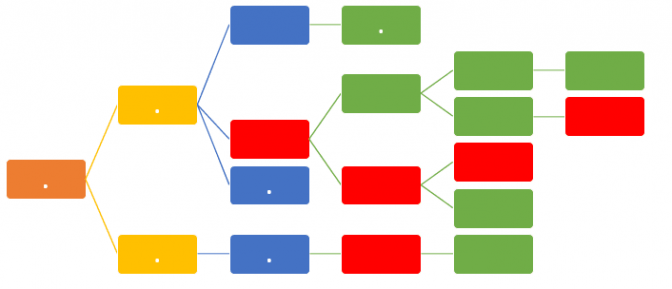Arrow diagramming method (ADM) is a network diagramming technique in which activities are represented by arrows.[1] It is also known as the Activity-On-Arrow (AOA) method. It has been used a long time to determine the critical path and identify resource problems and feasible solutions when the approximate duration and resource requirement of all the activities of the network diagram are known. In this Arrow Diagramming Method Example we will discuss the uses of arrow diagram and demonstrate the critical path calculation.
Table of Contents
What is an Arrow Diagram?
Before you begin, watch the video that illustrates an example. See how this tool visually represents the sequence of project tasks and their dependencies, aiding project teams in identifying the critical path and enhancing project planning.
An arrow diagram (also known as activity on arrow diagram, node diagram) is a vplanning and scheduling tool that determines the optimal sequence of activities. With the help of nodes, it provides a clear picture of the project duration through the Critical Path Method. In simple terms, an arrow diagram demonstrates the sequence of tasks and their durations required to complete the project. By following the forward pass and backward pass steps, you can easily calculate the critical path.
WHEN TO USE AN ARROW DIAGRAM?
- Creating a work schedule to plan and monitor project activities with resources.
- Understanding task sequences and each step to complete each task.
- Calculating the earliest and latest completion dates of the project and each task.
Arrows, Nodes and Dummy task
There are two main elements of the Arrow Diagramming Method (ADM) which are arrows and nodes. One arrow represents one activity to be performed. The tail of the arrow is the start of the activity, the head of the arrow is the end of the activity and the length of the arrow is the duration of the activity. (Figure 1)
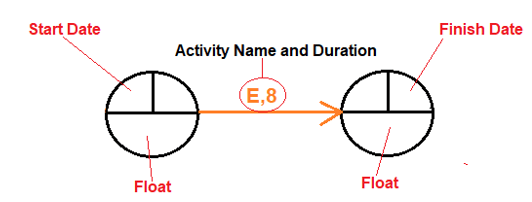
A dummy activity is not a real activity that is added to represent dependency between tasks. It can be used to separate tasks or to keep the sequence correct. The duration of a dummy task is often zero.
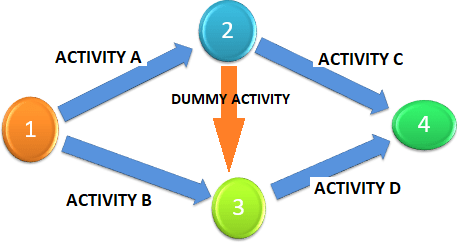
Figure 2: Dummy Activity
In the forward pass, we calculate the Start Dates of all the nodes. In the backward pass, the end node’s Start Date will be its Finish Date and the backward pass proceeds by subtracting the duration of the activities leading to the end node from the end node’s Finish Date to arrive at the Finish Dates for the preceding nodes.
How to create an activity on arrow diagram?
At first, create the activity network diagram and perform the critical path calculations.
1. Define Activities and Dependencies of Activity Network Diagram
Begin with defining all the activities involved in your project. After that identify the dependencies between activities by determining which tasks must be completed before others can begin.
2. Define Nodes And Arrows
Draw the network diagram by representing each activity wih a node and link the nodes with arrows. The first node is the beginning of the project and the last node is the end milestone. From the beginning to the end, arrows demonstrade the workflow.
3. Estimate Activity Duration
Estimate durations for each activity by considering resources and project requirements. There are 6 tools for activity duration estimates. You can select the one that fits your project’s requirements best.
1. Expert Judgment
2. Analogous Estimating
4. Three-Point Estimates
5. Reserve analysis
6. Group Decision Making Techniques
Note that estimating activity durations is an important process for critical path calculations. There are many project scheduling tools available for this purpose.
4. Determine the Critical Path
After creating the activity network diagram, the next step is to determine the critical path of the project. For better understanding, let’s review the example below.
Arrow Diagramming Method Example
The following example shows a simple Activity on Arrow Diagram.
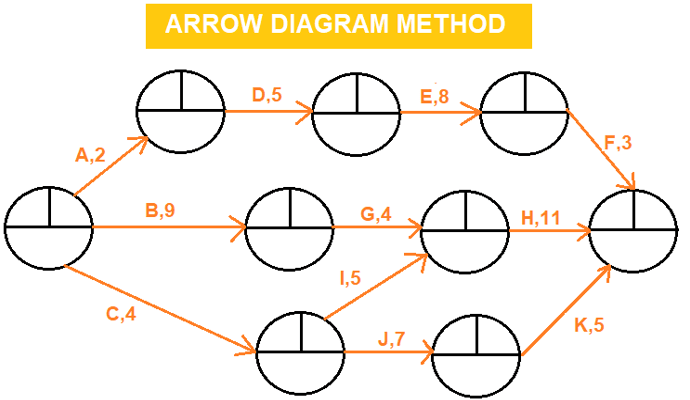
In this example A,B,C,D,E,F,G rows are representing the activities. Numbers above the rows are activity durations. As shown in the schema above only F-S Relationship is used to link activities.
Step 1: Forward Pass Calculation
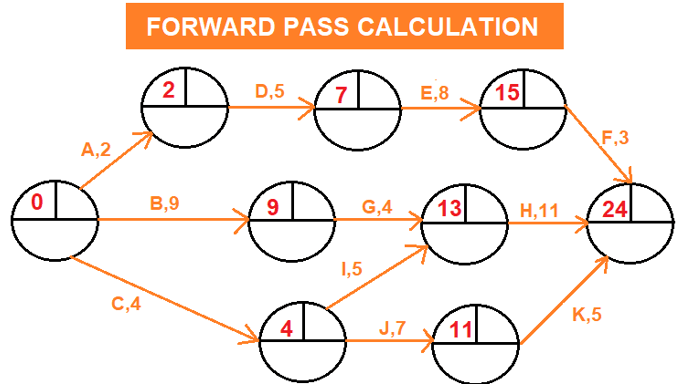
Starting from the 0 point (Start Milestone) perform the forward pass calculation to determine the earliest dates of the project. In the figure 4, earliest completion duration is 24 days.
Step 2: Backward Pass Calculation
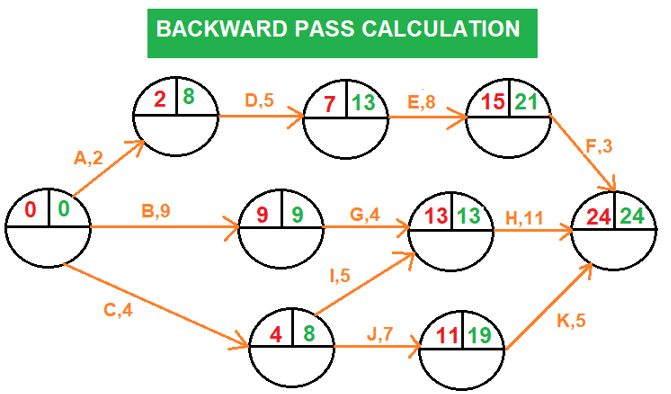
Now you will turn back from the finish milestone and calculate the latest completion date for each activity.
Step 3: Float Calculation for Each Activity
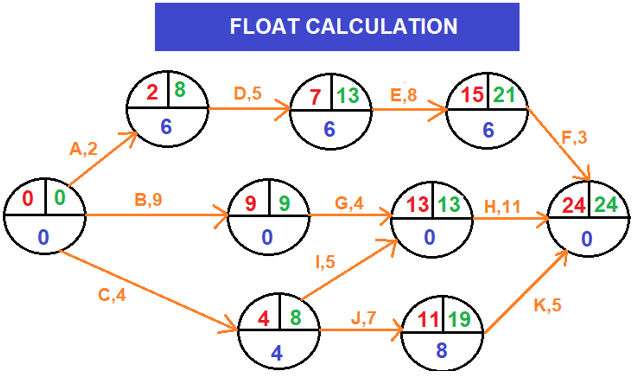
Float can be calculated by subtracting the Start Date of an activity from its Finish Date.
Total Float = LS – ES (or LF – EF)
Step 4: Identifying the critical path
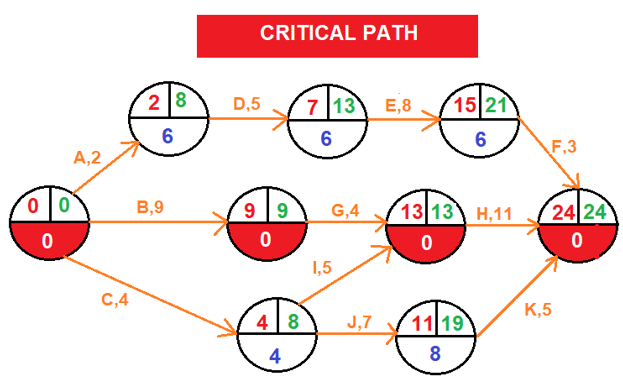
The critical path is the longest path in the network diagram and the total float of critical path is zero. As shown in the schema above, the critical path is marked red.
Summary
The Arrow Diagramming Method (ADM) and The Precedence Diagramming Method (PDM) are two network scheduling techniques. The first one is the traditional one used widely in the past. The second one is the current method that we are using widely now. In this simple arrow diagramming method example we show how to make forward, backward, total float and critical path calculation. Nowadays this method lost its popularity because of the introduction of software solutions but in order to use this software successfully, it is important to understand both scheduling techniques.
See Also
External References
[1] CPM in Construction – A Manual for General Contractors (Copyright 1965 by the Associated General Contractors of America)

Irma Gilda is chief executive of Sonic Training and Consultancy Co., the training platform offers project planning and scheduling More than 60 k learners have used the platform to attain professional success. Irma is a professional Primavera P6 Trainer.


